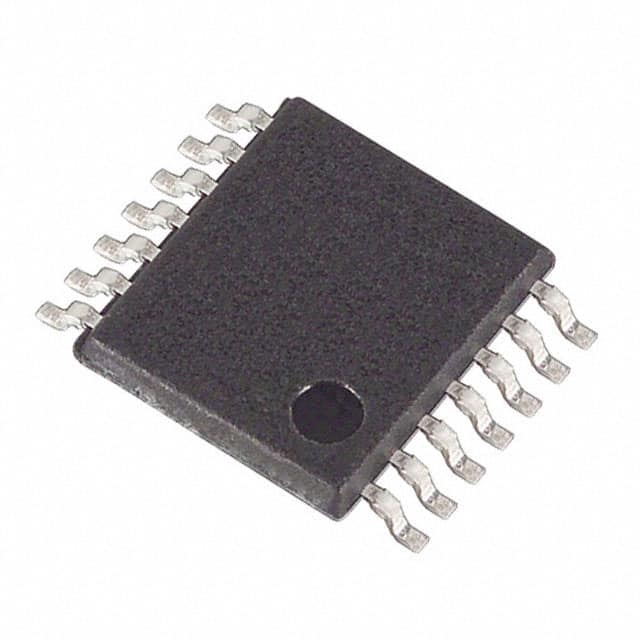Viz Specifikace pro podrobnosti o produktu.

MAX5393NAUD+ - English Editing Encyclopedia Entry
Product Overview
- Category: Integrated Circuit (IC)
- Use: Digital-to-Analog Converter (DAC)
- Characteristics: High precision, low power consumption
- Package: 8-pin µMAX® package
- Essence: Converts digital signals into analog voltages
- Packaging/Quantity: Available in reels of 2500 units
Specifications
- Resolution: 12 bits
- Supply Voltage Range: 2.7V to 5.5V
- Operating Temperature Range: -40°C to +85°C
- Output Voltage Range: 0V to VDD
- DNL (Differential Non-Linearity): ±1 LSB (max)
- INL (Integral Non-Linearity): ±2 LSB (max)
Pin Configuration
The MAX5393NAUD+ features the following pin configuration:
| Pin Number | Pin Name | Description | |------------|----------|-------------| | 1 | VDD | Power supply voltage input | | 2 | GND | Ground reference | | 3 | DIN | Digital input for data | | 4 | CS | Chip select input | | 5 | SCLK | Serial clock input | | 6 | LDAC | Load DAC input | | 7 | AGND | Analog ground reference | | 8 | OUT | Analog output voltage |
Functional Features
- High-resolution DAC with 12-bit resolution
- Low power consumption for energy-efficient applications
- Serial interface for easy integration with microcontrollers
- On-chip voltage reference for accurate conversions
- Software programmable gain and offset adjustments
- Power-on reset ensures reliable startup behavior
Advantages and Disadvantages
Advantages
- High precision and accuracy in converting digital signals to analog voltages
- Low power consumption makes it suitable for battery-powered devices
- Compact package size allows for space-efficient designs
- Wide operating temperature range enables usage in various environments
Disadvantages
- Limited output voltage range may not be suitable for certain applications requiring higher voltages
- Requires external components for proper operation, increasing overall system complexity
Working Principles
The MAX5393NAUD+ is a digital-to-analog converter that converts digital input signals into corresponding analog voltages. It utilizes a 12-bit resolution to provide high precision and accuracy in the conversion process. The device operates by receiving digital data through the DIN pin and using an internal voltage reference to generate the analog output voltage on the OUT pin. The serial interface (CS and SCLK) allows for easy communication with microcontrollers or other digital devices.
Detailed Application Field Plans
The MAX5393NAUD+ finds applications in various fields, including: 1. Audio equipment: Used for volume control, tone adjustment, and audio signal processing. 2. Industrial automation: Provides precise analog control signals for motor speed control, valve positioning, and sensor calibration. 3. Test and measurement instruments: Enables accurate signal generation and calibration in oscilloscopes, function generators, and data acquisition systems. 4. Communication systems: Used for modulation, demodulation, and frequency synthesis in wireless transceivers and base stations. 5. Automotive electronics: Provides analog control signals for automotive climate control systems, lighting controls, and engine management.
Detailed and Complete Alternative Models
- MAX5318: 10-bit resolution DAC with similar features and package options.
- MCP4921: 12-bit resolution DAC with SPI interface and different package options.
- AD5620: 12-bit resolution DAC with I2C interface and programmable gain options.
These alternative models offer similar functionality and can be considered based on specific application requirements.
In conclusion, the MAX5393NAUD+ is a high-precision digital-to-analog converter with 12-bit resolution. It offers low power consumption, a compact package, and a wide operating temperature range. While it has limitations in terms of output voltage range and external component requirements, its advantages make it suitable for various applications in audio equipment, industrial automation, test and measurement instruments, communication systems, and automotive electronics. Alternative models such as the MAX5318, MCP4921, and AD5620 provide additional options for designers seeking similar functionality.
Seznam 10 běžných otázek a odpovědí souvisejících s aplikací MAX5393NAUD+ v technických řešeních
Sure! Here are 10 common questions and answers related to the application of MAX5393NAUD+ in technical solutions:
Q: What is the MAX5393NAUD+? A: The MAX5393NAUD+ is a digital potentiometer IC (Integrated Circuit) that can be used to digitally control resistance in various applications.
Q: What is the operating voltage range of MAX5393NAUD+? A: The operating voltage range of MAX5393NAUD+ is typically between 2.7V and 5.5V.
Q: How many channels does the MAX5393NAUD+ have? A: The MAX5393NAUD+ has a single channel, which means it can control one potentiometer.
Q: What is the resolution of the MAX5393NAUD+? A: The MAX5393NAUD+ has a resolution of 256 steps, allowing for precise control over resistance values.
Q: Can the MAX5393NAUD+ be used in both audio and non-audio applications? A: Yes, the MAX5393NAUD+ can be used in both audio and non-audio applications, making it versatile for various technical solutions.
Q: Does the MAX5393NAUD+ support I2C communication? A: Yes, the MAX5393NAUD+ supports I2C communication protocol, which allows for easy integration with microcontrollers and other devices.
Q: What is the temperature range for the MAX5393NAUD+? A: The temperature range for the MAX5393NAUD+ is typically between -40°C and +85°C.
Q: Can the MAX5393NAUD+ be used as a variable resistor? A: Yes, the MAX5393NAUD+ can be used as a variable resistor by digitally controlling its resistance value.
Q: Is the MAX5393NAUD+ available in different package options? A: Yes, the MAX5393NAUD+ is available in a 10-pin µMAX package, which is a small and compact form factor.
Q: Can the MAX5393NAUD+ be used in battery-powered applications? A: Yes, the low operating voltage range of the MAX5393NAUD+ makes it suitable for battery-powered applications where power efficiency is important.
Please note that these answers are general and may vary depending on specific application requirements and datasheet specifications.

